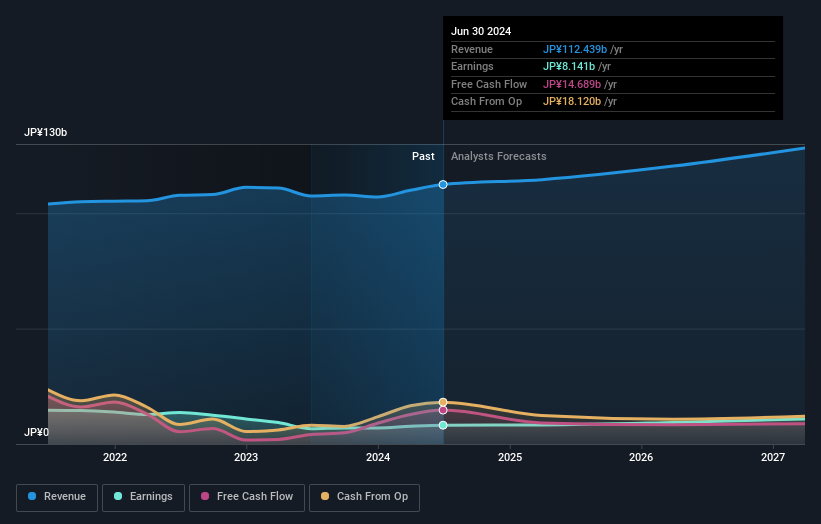- Japan
- /
- Electronic Equipment and Components
- /
- TSE:6754
While institutions invested in Anritsu Corporation (TSE:6754) benefited from last week's 10% gain, individual investors stood to gain the most

Key Insights
- The considerable ownership by individual investors in Anritsu indicates that they collectively have a greater say in management and business strategy
- 42% of the business is held by the top 25 shareholders
- 45% of Anritsu is held by Institutions
Every investor in Anritsu Corporation (TSE:6754) should be aware of the most powerful shareholder groups. With 55% stake, individual investors possess the maximum shares in the company. Put another way, the group faces the maximum upside potential (or downside risk).
While individual investors were the group that reaped the most benefits after last week’s 10% price gain, institutions also received a 45% cut.
Let's delve deeper into each type of owner of Anritsu, beginning with the chart below.
See our latest analysis for Anritsu

What Does The Institutional Ownership Tell Us About Anritsu?
Institutional investors commonly compare their own returns to the returns of a commonly followed index. So they generally do consider buying larger companies that are included in the relevant benchmark index.
We can see that Anritsu does have institutional investors; and they hold a good portion of the company's stock. This suggests some credibility amongst professional investors. But we can't rely on that fact alone since institutions make bad investments sometimes, just like everyone does. It is not uncommon to see a big share price drop if two large institutional investors try to sell out of a stock at the same time. So it is worth checking the past earnings trajectory of Anritsu, (below). Of course, keep in mind that there are other factors to consider, too.

Hedge funds don't have many shares in Anritsu. The company's largest shareholder is Nikko Asset Management Co., Ltd., with ownership of 6.8%. In comparison, the second and third largest shareholders hold about 5.2% and 3.8% of the stock.
Our studies suggest that the top 25 shareholders collectively control less than half of the company's shares, meaning that the company's shares are widely disseminated and there is no dominant shareholder.
Researching institutional ownership is a good way to gauge and filter a stock's expected performance. The same can be achieved by studying analyst sentiments. There are plenty of analysts covering the stock, so it might be worth seeing what they are forecasting, too.
Insider Ownership Of Anritsu
While the precise definition of an insider can be subjective, almost everyone considers board members to be insiders. Company management run the business, but the CEO will answer to the board, even if he or she is a member of it.
Insider ownership is positive when it signals leadership are thinking like the true owners of the company. However, high insider ownership can also give immense power to a small group within the company. This can be negative in some circumstances.
Our most recent data indicates that insiders own less than 1% of Anritsu Corporation. It's a big company, so even a small proportional interest can create alignment between the board and shareholders. In this case insiders own JP¥108m worth of shares. Arguably, recent buying and selling is just as important to consider. You can click here to see if insiders have been buying or selling.
General Public Ownership
The general public, mostly comprising of individual investors, collectively holds 55% of Anritsu shares. This size of ownership gives investors from the general public some collective power. They can and probably do influence decisions on executive compensation, dividend policies and proposed business acquisitions.
Next Steps:
It's always worth thinking about the different groups who own shares in a company. But to understand Anritsu better, we need to consider many other factors. For instance, we've identified 1 warning sign for Anritsu that you should be aware of.
Ultimately the future is most important. You can access this free report on analyst forecasts for the company.
NB: Figures in this article are calculated using data from the last twelve months, which refer to the 12-month period ending on the last date of the month the financial statement is dated. This may not be consistent with full year annual report figures.
New: Manage All Your Stock Portfolios in One Place
We've created the ultimate portfolio companion for stock investors, and it's free.
• Connect an unlimited number of Portfolios and see your total in one currency
• Be alerted to new Warning Signs or Risks via email or mobile
• Track the Fair Value of your stocks
Have feedback on this article? Concerned about the content? Get in touch with us directly. Alternatively, email editorial-team (at) simplywallst.com.
This article by Simply Wall St is general in nature. We provide commentary based on historical data and analyst forecasts only using an unbiased methodology and our articles are not intended to be financial advice. It does not constitute a recommendation to buy or sell any stock, and does not take account of your objectives, or your financial situation. We aim to bring you long-term focused analysis driven by fundamental data. Note that our analysis may not factor in the latest price-sensitive company announcements or qualitative material. Simply Wall St has no position in any stocks mentioned.
About TSE:6754
Anritsu
Develops, manufactures, and sells electronic measurement instruments and systems for various communications applications in Japan and internationally.
Flawless balance sheet with proven track record and pays a dividend.

